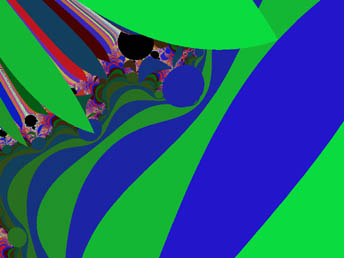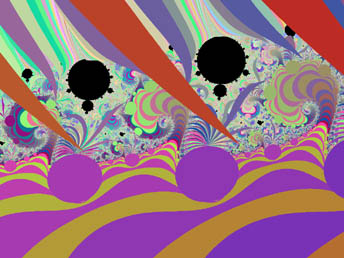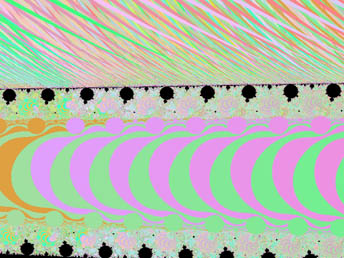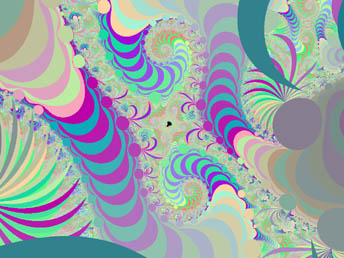
click here or image to see larger annotated version
Mandelbrot Fractal Butterfly
showing relation to natural forces
and cosmological eras
The Mandelbrot Set
and Cosmology
by Jonathan J. Dickau ©'97,'06 - all rights reserved
Chapter Three
Approaching Decoupling - the Matter/Energy Cloud Expands
In order to continue our exploration into the parallels between the progression of form on the boundary of the Mandelbrot Set and the progression of events described by Cosmology we must discuss the coupled state of matter/energy, and how matter and energy become separate entities. Standard Cosmology, or Big Bang theory, describes a progression of events stretching back to less than a second after cosmic expansion began. During the first few instants, a range of sub-atomic particles was created. The Hadrons, or heavy particles, were the first to appear in our universe. This group includes protons, neutrons, antineutrons, various types of mesons, and they are made of several flavors of quarks. These predominated for only an instant, however, and were largely supplanted by lighter particles called Leptons. These entities include electrons, positrons (anti-electrons), and neutrinos. The total period of time during which the universe was creating sub-atomic particles lasted for only about a second. After this, it is believed the universe assumed the form of a kind of matter-energy cloud, where energy was occasionally transforming into matter, and objects of matter and antimatter were continually annihilating each other, turning into energy, which was again reborn as particles continuing the cycle of energy exchanges.

It can be said that matter and energy were actually coupled, during this era of the universe, as it wasn't possible for a particle to travel for more than about a meter before it collided with another particle (or perhaps an anti-particle, turning both back to energy). Similarly a photon of light couldn't travel very far either, without bumping into something. But space itself was expanding, and this changed things enough for other forces to emerge as predominantly independent entities, where there had been a unified force before. That is; the familiar faces of the natural forces began to assert themselves, as those same forces became distinguishable one from the other. The essential notion here is that fireball of the early universe was expanding rapidly, and the same amount of heat, spread over a larger volume of space, represents a lower temperature. As water cools it turns from steam into liquid water, which hardens into ice, if it is cooled still further. In the early universe, both form and forces were still solidifying, and the Weak Nuclear force was the next to emerge and predominate. As the Weak Nuclear Force worked to spin apart forms, the expansion of the universe continued and quietly, inexorably, things cooled enough to allow atomic nuclei to begin forming from the remaining heavy sub-atomic particles (hadrons). Each time this happened, some of the excess energy was involved in binding reactions (i.e. - tied up in making particles or nuclei), and this caused the universe to cool still further.
Note that the spontaneous creation of particles, the binding of these particles into atomic nuclei, and the splitting of these entities back into energy continued efficiently for some time. However, even the most efficient transformations lose some energy in the process of exchange. The temperature of the early universe was so high that a pool of energy was always available to draw upon. Ever higher energies were required to continue the process, however, and at some point there wasn't quite enough latent heat to keep the constant matter-energy exchanges going. The fog of matter and energy started to lift, or became somewhat transparent. At this point, gaps appeared, the photons of energy escaped the cloud, the nuclei combined with the free electrons to form atoms and the decoupling of matter and energy began. Before that point, energy was contained by the matter/energy fog as it had nowhere else to go. The expansion of the fireball or matter/energy cloud is now believed to have taken about 380,000 years, at which point the decoupling of matter and energy took place rather quickly.
If the Butterfly Wings in our opening figure (and below) represent energy exchanges, and the circular objects represent particles, nuclei, and atoms in turn, then we would expect to see them again obscuring the form around the edge of the set, in areas representing that time when annihilation of particles is expected to happen. In fact, this is exactly what we do see, in the image below, as we go around the outer edge of the cardioid shape. But if we continue still further out on the curve, the butterfly wings subtend the edges, however they don't totally obscure the detail around those edges. Instead, we see a delightful interplay of circular forms, with butterfly wings, and with the edges of the Mandelbrot Set itself. The gaps provide a window into the dynamic activity, at the boundary. This allows us to view and examine, in abstract form, the ways energy shapes the forming process in the early universe, and to study the interactions between matter and energy which these forms represent. In my view, what is represented by the form in this region is the manner in which the weak force assertsts itself, and the process of nucleosynthesis.

If one continues along either edge (from (0, -i) or (0, i)) toward the point -0.75, or (-0.75, 0i), where the two sides of the cardioid shape almost meet, there is a progression of forms into curves and/or spirals. As one approaches the real axis, (-0.75, 0i), the curves and spirals become tighter, and tighter, spinning outwards, away from the center or axis. At one point on either side (left of center on above magnification), there is also a feature where one of the circular discs is neatly split by the point of one of the butterfly wings (energy bands), and there are numerous partial examples of this. One effect the Weak Nuclear force has is the fission of atomic nuclei, or the splitting of atoms, and this appears to be depicted here quite clearly, in the image above. But the predominant dynamic of the weak-nuclear force is spin, and the features in this region of the Mandelbrot Set certainly depict that quality, in ever-tightening spirals. The Butterfly Wings also seem to show a spin-inducing application of energy.

When people talk about splitting atoms, what is actually meant is that the nucleus of that atom is being split. This can be said to result from the accumulation of too much sub-atomic spin in that nucleus (or of a nucleus trying to spin in two or more different directions at once), which causes it to fly apart from an effect similar to centrifugal force. The Weak Nuclear force relates to the conservation of sub-atomic spin within objects or systems, and this attribute is associated with the entities known as Neutrinos. There is now evidence for three flavors of neutrinos, and for weak messenger particles which are known as the W and Z bosons. Various aspects of the Weak Nuclear Force are depicted in abstract form along the entire periphery of the descending curve (on either side of the cardioid) in the Mandelbrot Fractal Butterfly figure, and both the number, and extent of spin-related effects on form increases as one approaches the funnel point at (- 0.75, 0i). There is a progression of forms where lines become curves, and those curves develop into tighter and tighter spirals, as one zooms in on successive blips along the edge of the Set.

This progression of form appears to indicate a situation where both tighter spirals, and higher-order or multiple spirals, involve higher energies and more energy. The greater numbers of calculation cycles, or iterations, required to resolve a particular feature, or form, reflects the greater difficulty of manifesting this form. This is directly related to the energy expended in creating, or expressing, particular forms. One can see down into the well of some spirals only at very high iterations. That is; only after many computational cycles can these features be seen at all. Features requiring a lot of computational effort to resolve may represent those forms which are less probable, in terms of the quantum probabilities of various systems and spaces. As stated before, energy likes to follow the path of least resistance, and form likes to assume configurations which allow it to exist in the lowest energy state possible. Forms requiring a higher energy to realize (or equivalently more computational power) are therefore less likely to manifest.

Correspondingly, those features which require less calculation to resolve than their neighbors may indicate that those forms have a higher probability of manifestation. If the butterfly wings are seen as the matter-energy transformations in the pre-decoupling phase of the universe's unfoldment, it is notable that these energy bands provide favorable pathways for the release of mass-energy wherever they appear. The fact that the Butterfly Wings extend into the edge, or subtend some of the other forms (i.e. - the circular shapes), indicates specifically that the wings require fewer calculations (less energy) to resolve (or create) than the forms they overlie. However, only some of the objects on the periphery of the Set are intersected by the energy-exchange bands, and many of these somewhat obliquely.
Those circular objects that are touched by the bands exhibit shapes which strongly suggest the fission of atomic nuclei. The splitting of the nucleus, conversion of part of its mass into energy, and the (fission) products thereof are all graphically depicted. Other interesting structures are also visible in this area of the Set; plumes emanate from each particle which may represent secondary breakdowns, and/or weak-neutral currents. The circular figures in the region of (0, i) and (0, -i) each have one plume, of sorts, in the form of a roughly semi-circular figure nearby. But this is just the start of something wonderful. As one continues, along the edge toward (-0.75, 0i), which I call the funnel point, the plumes on each figure become more numerous, and are also elongated into beautiful featherlike shapes. On the othe side of the barrier at -0.75, the butterfly wings disappear entirely, and the elaborate plumes become a tiny vestige of plumage.
In some areas, these plumes intersect some of the smaller circular objects, appearing to split them as the Butterfly Wings do with some of the larger discs. Continuing the metaphor would lead us to suggest that the plumes are also pathways for energy exchanges involving the circular objects which they emanate from or touch. The Weak Nuclear Force is associated with breakdown reactions which act upon those sub-atomic entities (particles and atomic nuclei) with high internal energy to fragment into lower energy forms. We speak of the Half-Life of these entities, which is the time during which half of a collection of similar entities can be expected to decay. When such a decay happens, matter is converted back into energy. The nuclei, or atomic cores, absorb energy (from photons or particle collisions) in order to be made to react, and liberate energy when they are split.
It should be noted that there was an exquisite balance between binding and liberating forces during this cosmological era, owing to the fact that the interactions which convert mass into energy, and bind energy into mass-bearing entities, are so wonderfully efficient. The action of the Weak force during this time is rather subtle, but it has telling effects. You see, most of the sub-atomic entities which comprise our universe (including protons, neutrons, and electrons) can only exist when they are spinning. If they are viewed as loops of energy, we can make the analogy sub-atomic particles must spin in order for that energy to catch its own tail, forming the circuit which keeps them intact. Stated another way, the waves must match, where the energy feeds into itself. When the Color Force binds energy into particles, a small portion of the energy is lost (often as a neutrino), and the constant spin of each sub-atomic particle makes up for this exact amount of spin-energy.
The problem is that only the proper amount of spin will do the trick. Without the right spin, the particle will collapse, but too much spin would cause it to fly apart. A balance of the forces which expand and forces which condense form is required for those entities to remain intact. The Strong Nuclear force is very powereful indeed and binds particles together, but only it acts at very short distances. And aggregate forms like nuclei become a collection of various spinning entities nesting together, which makes things both interesting and complicated. Atoms of lighter elements contain nuclei where there is a nice balance of forces, and this allows them to be especially stable. The Fusion of light nuclei releases energy, and creates heavier elements in the process. As one goes up the Periodic Table, however, the amount of energy required to evolve a nucleus for a given atom increases, and the amount of excess energy liberated during Nuclear Fusion decreases instead. Past the element Iron, one needs to put more energy in to build a nucleus, than one will liberate with the reaction.
However; only the very lightest elements are believed to have survived the decoupling era, according to conventional theory. Only Hydrogen, Helium, and a bit of Lithium remain from the era of the expanding or inflating fireball. What the Mandelbrot Set seems to depict in this region includes the whole pattern, instead, for nucleosynthesis of heavier elements. It shows the entire range, including those elements we believe originated only in dying stars. But it also shows something very interesting happening at the boundary where decouplng takes place. The barrier between the space above and below the funnel point seems quite imposing, and it results in another broken symmetry. It looks as though it depicts space turning inside out, at the moment of decoupling, and like anything larger than a particular size is effectively trapped behind that boundary (such as heavy nuclei). This could explain the observed distribution of ancient elements, and account for some of the so-called missing matter in the universe.
What we see now in the universe includes the products of billions of years of stellar evolution. One generation of stars is born, dies, and shares its end products with new stars, planets, nebulae, and other heavenly bodies of all descriptions. A wide range of the chemical elements is available to us on this planet, but much of the more interesting stuff is a product of supernova explosions of long-dead stars. But it wasn't always that way, and those elements had to be built up from nothing, or at least from much simpler stuff. This takes place when stars begin to exhaust their fuel, and must re-group in order to keep on generating energy and survive. The burn up first hydrogen, then helium, and so on up the scale. However; it is the same process I spoke of above, nucleosynthesis. Suffice it to say that this process can create all the heavy nuclei, even those of the radioactive elements. But I suppose I should explain what this means.
Very heavy elements are increasingly unstable. Many will break down spontaneously, and these elements are said to be radioactive. The individual spins of the particles which comprise the nucleus of an atom of Uranium, for example, can only nest together with difficulty, and this tends to result in forces which will eventualy pull that nucleus apart. But this makes Uranium (or other radioactive elements) very tough to create, and in the presence of high energies and constant bombardment, it is not likely to exist for long and may not form at all. In the early universe, it would seem, the conditions were not favorable for heavy elements to exist. The elemental building process (of forming nuclei of heavier elements) did proceed, however, for about a third of a million years before decoupling. The process called Nucleosynthesis evolved heavier nuclei continually, as the universe cooled and expanded, and the process of creating heavier elements resulted in form involving (or encapsulating) higher, and higher, amounts of energy. That is; heavier elements allow more and more energy to be stored as substance, and turned into matter. This pattern is rather graphically depicted in the detail of the Butterfly shape, in the region of the Set which corresponds to this era.
The number of calculations required to resolve the various features of the Mandelbrot Set or Fractal Butterfly figure becomes higher, and higher, as one proceeds towards an open edge, or along the edge of the cardioid toward the funnel point. However; that number is constant for any of the wings that reach out from the center to the edge, along their entire length. It appears as if the objects, and phenomena, depicted are trying to soak up, or involve the available energies. This is precisely what happened in the cosmological era prior to decoupling. The Weak-nuclear force became a distinct entity, and was predominant for about 380,000 years as the early universe expanded and cooled. When the Weak force had no more cards (breakdown and scattering reactions) to play, in order to receive photonic energy and liberate the energy bound up in forms, light (actually gamma rays) started to leak out of clear patches in the matter-energy fog, and this ended the era when direct matter-energy exchanges were predominant. Accordingly, on the other side of the funnel point, the Butterfly Wings disappear.
©'97,'06 Jonathan J. Dickau - all rights reserved
Single copies for reference or personal use are allowed,
but reproduction for commercial purposes is not permitted.
This document is part of a detailed rendering of a theory
which was first published in November of 1987,
in a publication called Amygdala.
This page was revised, and expanded,
on August 7, 2006
the next chapter
The Electromagnetic Force -
the age of Atoms and Molecules
the previous chapter
Early Forces - Comological
Isomorphism in the Beginning
Return to
Feature Articles
page last updated on
August 7, 2006
- jd